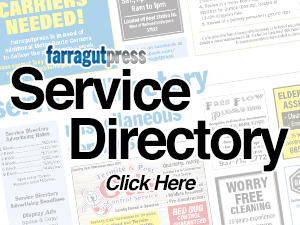Easing K-Pike- Campbell St. jams?
Jamestowne Blvd. could be answer
To help relieve traffic congestion in Town, especially at the Kingston Pike-Campbell Station Road intersection, Farragut Board of Mayor and Aldermen approved an agreement with Tennessee Department of Transportation to study Jamestowne Boulevard as an alternate route.
The study as approved would determine if improvements to Jamestowne Boulevard “might provide an efficient bypass of the intersection for motorists on both routes,” stated a report on the matter. “Anticipated improvements will likely be traffic signals, a center turn lane and modifications of both ends of Jamestowne.”
“As traffic volumes continue to grow throughout the Town, an efficient network of streets becomes vitally important,” Town engineer Darryl Smith stated in a separate report. “The eastbound left turn movement from Kingston Pike to northbound Campbell Station Road is particularly volatile as the intersection is reaching its capacity.”
Current funding for the study is $80,000 with an 80/20 federal/local split, so the Town will be responsible for 20 percent ($16,000),” the report further stated.
“TDOT will reimburse the federal share of $64,000 as work progresses.”
Traffic networking plans
The Board passed several business items Dec. 10 designed to address ongoing traffic concerns.
The business items approved cost just under $1 million, but are reimbursable as the Townwas approved last year for nearly $7 million in Congestion Mitigation/Air Quality federal funding that will upgrade its current traffic signal network under the project title Advanced Traffic Management System Phase 1.
“The project will upgrade our current network of 26 traffic signals to a Town-wide centrally controlled system with up to six cameras, including replacement of signal controllers, radar vehicle detection, communication system and other hardware,” a report from Town engineer Darryl Smith stated.
In a separate interview Monday, Smith said, “Once the project is completed, it should be much easier for us to detect when problems arise, as well as to spot trends in traffic volumes that would necessitate timing adjustments.
“It’s important to note the project will be an improvement, but not a complete fix to all congestion problems,” he added.
“When volumes reach capacity, there will still be congestion. We want the ability to spot problems quickly, and the flexibility to make adjustments as needed.”


